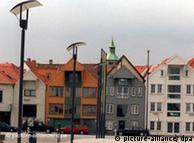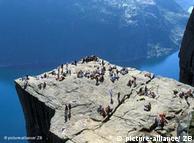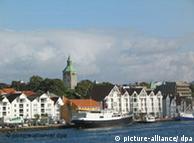Culture | 03.01.2008
Norway's Oil Capital Becomes European Center of Culture
Stavanger, Norway's fourth largest city, is better known for oil than for culture. But as one of this year's European Culture Capitals, the Hanseatic city is focusing on its past.
Under the motto "Open Port," Stavanger is out to shed its image as an oil town and attract visitors from around the world with a year-long series of festivals, plays, architectural projects, concerts, natural excursions and more.
Unlike Liverpool, which shares the European Culture Capital title, Stavanger can't completely bank on the Beatles, but it has turned to an aptly named fab four song, "Norwegian Wood," for a PR boost.
Wooden houses by the sea
The town on the North Sea has the highest concentration of old wooden buildings in Europe -- and will soon have even more as part of a project that shares the name of the Beatles hit.
 Bildunterschrift: Großansicht des Bildes mit der Bildunterschrift: Wooden houses are anything but hard to find in Stavanger
Bildunterschrift: Großansicht des Bildes mit der Bildunterschrift: Wooden houses are anything but hard to find in Stavanger
A team of international architects will construct modern houses, schools, theaters, bridges and other structures out of wood to complement the existing 18th century counterparts. An exhibition is planned for November.
With a relatively modest budget of 37 million euros ($54 million) for some 180 events, Stavanger hasn't invited any major celebrities. Much of the program has a regional touch -- like the kite, tomato and folklore festivals -- but artists-in-resident from South Africa, Belgium, Lithuania and Israel will also give it an international flair.
The Lithuanian theater group Oskaras Korsunovas, for example, will be performing contemporary versions of Shakespeare plays. Again, the British connection is a reference to its cultural capital partner.
Israel's Inbal Pinto Dance Company, in Norway for a month, will present their shows "Oyster" and "Shaker" independently and also join with local dancers for a combined show.
"We don't want celebrities that climb out of the airplane, perform and then disappear again," said project spokeswoman Bente Aae of the artists-in-residence.
Fishing, canning and oil
With nearly 120,000 residents, Stavanger has a long fishing tradition, but in the 19th century, when herring became scarce, canning became its most important industry. At one time, it was the world's largest canning center with more than 50 canning factories.
In the mid-20th century, North Sea oil took off and the coastal town reoriented to make the most of the black gold, which proved much more profitable than fishing and canning.
The Stavanger Maritime Museum, the Norwegian Canning Museum and the Norwegian Petroleum Museum all offer visitors as glimpse into the town's industrial background. The European Cultural Capital festivities open with an official ceremony on Jan. 12.
 Bildunterschrift: The 600-meter high Prekestolen cliff is a highlight on Stavanger's coast
Bildunterschrift: The 600-meter high Prekestolen cliff is a highlight on Stavanger's coast

沒有留言:
張貼留言